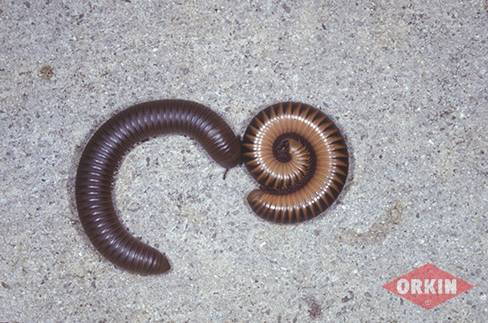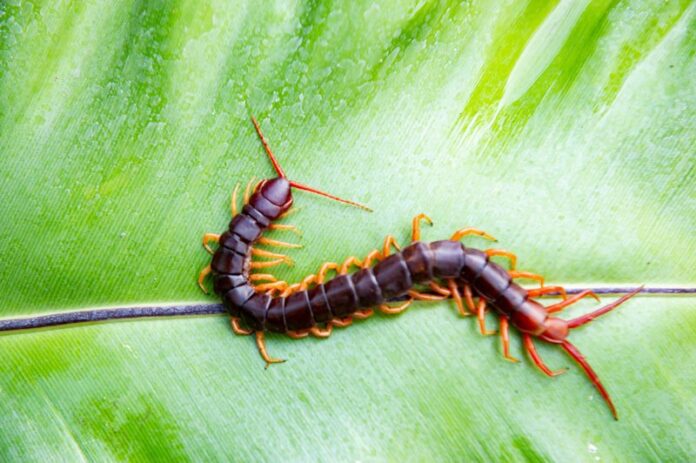Millipedes are not poisonous to humans as they do not produce venom.
Understanding Millipedes
Millipedes are intriguing creatures that often evoke curiosity and sometimes even fear. Understanding these multi-legged creatures can help dispel any misconceptions and provide insights into their behavior and characteristics. In this section, we will explore what millipedes are, different types of millipedes with accompanying pictures, and the key differences between millipedes and centipedes.
What Are Millipedes?
Millipedes belong to the arthropod class Diplopoda, which means “double-legged” in Greek. They are elongated, worm-like creatures characterized by their numerous pairs of legs. Contrary to their name, millipedes do not have a thousand legs. However, they do possess an impressive number of legs, with most species having between 30 to 400 pairs.
Types Of Millipedes With Pictures
Millipedes come in a variety of shapes and sizes, each with distinct features and adaptations. Here are some common types of millipedes you may come across:
| Millipede Type | Image |
|---|---|
| Yellow-spot millipede |  |
| Archispirostreptus gigas |  |
| American giant millipede |  |
| Greenhouse millipede |  |
Differences Between Centipedes And Millipedes
While centipedes and millipedes may appear similar at first glance due to their elongated bodies and multiple legs, they belong to different classes and exhibit distinct characteristics. Here are some key differences:
- Centipedes (class Chilopoda) have one pair of legs per body segment, while millipedes (class Diplopoda) have two pairs of legs per segment.
- Centipedes are generally predatory and have venomous pincers to capture and immobilize their prey. In contrast, millipedes are decomposers, feeding primarily on dead plant matter and decaying organic material.
- Centipedes have a flatter body shape and move swiftly, while millipedes have a cylindrical body shape and move more slowly.
- Centipedes are typically more aggressive and prone to biting when threatened, whereas millipedes generally rely on defensive mechanisms like curling into a spiral or releasing toxins to deter predators.
By understanding the distinguishing features of millipedes and their differences from centipedes, we can appreciate the unique attributes and fascinating world of these intriguing creatures.

Credit: www.youtube.com
Are Millipedes Poisonous To Humans?
Are Millipedes Poisonous to Humans?
Toxin Release By Millipedes
Millipedes are worm-like bugs that belong to the class Diplopoda. While they may appear intimidating, millipedes are generally harmless to humans. They do not produce venom like their cousin, the centipede. However, certain types of millipedes have a defense mechanism to protect themselves when threatened or handled roughly – they release a harmful substance called toxin.
Misconception alert: It is important to note that not all millipedes possess toxins. Only a specific group of millipedes releases toxins as a defense mechanism.
Effects Of Millipede Bites
If you happen to come into contact with a millipede that releases toxin, it is important to be aware of the potential effects. While millipedes do not bite, their toxins can cause irritation, especially if accidentally rubbed into the eyes or other sensitive areas of the body. The resulting discomfort can range from mild irritation to a more pronounced reaction.
A common remedy for alleviating the discomfort caused by a millipede toxin is to place an ice cube wrapped in a cloth on the affected area. This can help relieve the pain and reduce inflammation.
Important: In case of severe symptoms or allergic reactions, it is recommended to seek medical attention.
Misconceptions About Millipedes And Venom
It is essential to distinguish between millipedes and centipedes when it comes to venom. While centipedes are venomous creatures capable of delivering painful bites, millipedes are comparatively harmless. As mentioned earlier, only a specific group of millipedes release toxins, and their venom is not as potent as that of centipedes.
Some people mistakenly confuse millipedes with centipedes and assume that millipedes are venomous. However, this is a misconception. Millipedes are generally docile and pose minimal risk to humans.
Remember, when encountering millipedes, it is advisable to handle them with care and avoid any direct contact with bare skin, especially if you are unsure whether they belong to the toxin-releasing group.
Risks Of Handling Millipedes
Millipedes, those fascinating creatures with numerous legs, can be intriguing to observe. However, it’s important to be aware of the potential risks associated with handling these insects. In this section, we will explore the dangers of picking up millipedes, the hydrochloric acid present in their defensive sprays, and the precautions you should take when handling them.
Dangers Of Picking Up Millipedes
Picking up millipedes may seem harmless, but it can lead to unwanted consequences. Certain types of millipedes have a defensive mechanism where they release a harmful substance or toxin when threatened or roughly handled.
The toxin that millipedes release can cause skin irritation, especially if you have sensitive skin. In some cases, the toxin may even cause a mild allergic reaction, leading to redness, itching, or a rash.
It is essential to avoid picking up millipedes with your bare hands to minimize the risk of coming into contact with their toxin.
Hydrochloric Acid In Millipede Defensive Sprays
One of the main components of millipedes’ defensive sprays is hydrochloric acid. This acid can be harmful to your skin and may cause burns or discoloration if you come into direct contact with it.
If you accidentally touch a millipede’s defensive spray, it’s crucial to wash the affected area immediately with soap and water. This will help neutralize the acid and minimize any potential damage to your skin.
Remember, prevention is key. Avoid handling millipedes without proper protection, such as gloves or a barrier, to steer clear of any contact with their defensive sprays.
Precautions For Handling Millipedes
To ensure your safety when handling millipedes, there are a few precautions you should take:
- Wear gloves or use a barrier method such as a plastic bag or container when picking up millipedes. This will protect your skin from direct contact with their toxin or defensive sprays.
- Avoid touching your face or eyes when handling millipedes or their residue. The hydrochloric acid present in their defensive sprays can cause eye irritation or damage if it comes into contact with your eyes.
- After handling millipedes, make sure to wash your hands thoroughly with soap and water. This will remove any residue or odor left by the insects and minimize the risk of inadvertently spreading the toxin to other parts of your body or objects.
By following these precautions, you can safely observe millipedes without exposing yourself to unnecessary risks.

Credit: www.callnorthwest.com
Allergic Reactions And Skin Discoloration
Millipedes may not be known for their venomous bites, but they can still cause allergic reactions and skin discoloration. Understanding the irritating fluids produced by millipedes and the hydrochloric acid in their defensive sprays is crucial in recognizing the potential risks. In this section, we will explore the effects of these substances on human skin, as well as their long-term impact.
Irritating Fluids Produced By Millipedes
When threatened or handled roughly, certain types of millipedes release irritating fluids from special glands on their bodies. These fluids can cause skin irritation and redness, resulting in discomfort and itching. While not poisonous, these fluids can still elicit allergic reactions in some individuals, especially those with sensitive skin.
Hydrochloric Acid In Defensive Sprays
Some millipedes possess an additional defense mechanism in the form of hydrochloric acid. When these millipedes feel threatened, they release a spray containing hydrochloric acid as a deterrent. This acidic fluid can cause a burning sensation on contact with the skin and may even lead to skin discoloration.
It is important to note that the severity of the reaction can vary depending on the individual’s sensitivity and the species of millipede. Some people may experience only mild discomfort, while others may develop more pronounced symptoms.
Long-term Skin Discoloration
In certain cases, the contact of hydrochloric acid with the skin can result in long-term skin discoloration. This discoloration might appear as dark spots or patches and can take time to fade away completely. It is advisable to avoid picking up millipedes with bare hands to prevent any potential risks.
If you do come into contact with millipedes and notice skin discoloration or persistent irritation, it is recommended to wash the affected area thoroughly with soap and water. Applying a mild hydrocortisone cream or antihistamine lotion may also help alleviate any discomfort or itching.
In conclusion, while millipedes are not poisonous, they can still cause allergic reactions and skin discoloration. Understanding the effects of the irritating fluids produced by millipedes and the hydrochloric acid in their defensive sprays is essential in minimizing any potential risks. If you have sensitive skin or are prone to allergic reactions, it’s best to exercise caution when handling millipedes to avoid any unpleasant consequences.
Comparison With Centipedes
Unlike centipedes, millipedes are not poisonous. Millipedes release a toxin if threatened, but it is not harmful to humans. They are generally harmless and docile creatures.
Venomous Nature Of Centipedes
Centipedes are well-known for their venomous nature, making them quite different from millipedes. These fascinating creatures have venomous claws known as forcipules, located at the front of their body. These forcipules deliver venom to subdue their prey before feeding on it. It’s important to note that centipedes are not considered a significant threat to humans. Although their venom can cause pain and discomfort, it is not usually life-threatening.
Differences In Hunting Behavior
Centipedes and millipedes also differ in their hunting behavior. Centipedes are active hunters, using their excellent speed and agility to capture their prey. They rely on their venom and powerful jaws to subdue and consume insects, spiders, and even small vertebrates. On the other hand, millipedes are detritivores and scavengers. They primarily feed on decaying plant material, fungi, and organic matter found on the forest floor. Unlike centipedes, millipedes are not equipped with venomous claws and rely on their sheer numbers and mobility to survive.
Different Types Of Centipedes And Millipedes
There are various types of centipedes and millipedes, each with its own unique characteristics. Let’s take a closer look at some of them:
Stone Centipedes
Stone centipedes, also known as lithobiomorphs, are commonly found in gardens, fields, and forests. These centipedes have long bodies and numerous pairs of legs. They are known for their excellent climbing abilities and can often be found hiding under rocks or logs.
House Centipedes
House centipedes, also known as scutigeromorphs, are commonly found indoors in damp and dark areas such as basements and bathrooms. Despite their creepy appearance, they are beneficial insects as they prey on other household pests like spiders, roaches, and silverfish.
Yellow-spot Millipedes
Yellow-spot millipedes, also known as archispirostreptus gigas, are one of the largest millipede species. They can reach lengths of up to 10 inches and have a yellowish-brown coloration with distinct black spots. These millipedes are native to East Africa and are often kept as pets due to their unique appearance.
American Giant Millipedes
American giant millipedes, also known as narceus americanus, are commonly found in the southeastern United States. These millipedes are known for their vibrant coloration, with a black body and yellow legs. They are harmless and can reach lengths of up to 4 inches, making them a popular choice for educational purposes.
In conclusion, while both centipedes and millipedes belong to the same phylum, they have distinct differences in their venomous nature, hunting behavior, and various species. Understanding these differences allows us to appreciate the diversity and fascinating characteristics of these unique creatures.

Credit: www.orkin.com
Frequently Asked Questions Of Are Millipedes Poisonous
Why Shouldn’t You Touch A Millipede?
Millipedes release a harmful toxin if threatened or handled roughly. So, it’s best not to touch them.
What Happens If You Get Bitten By A Millipede?
Millipedes do not bite humans, but they may release a toxin that can be irritating, especially if it gets into your eye. Applying an ice cube wrapped in cloth can help relieve any pain caused by a millipede bite. Millipedes are generally harmless and not poisonous to humans.
Are Millipedes Poisonous To Humans?
Millipedes are not poisonous to humans. They don’t bite and don’t produce venom. Some millipedes can release a harmful substance if threatened or handled roughly, but they are generally harmless and docile. It’s best to avoid touching them to prevent any potential irritation or allergic reactions.
Is It Safe To Pick Up A Millipede?
It is not safe to pick up a millipede with bare hands. Some millipedes have defensive sprays containing hydrochloric acid, which can burn or discolor the skin and cause eye irritation. It is best to avoid touching millipedes and to wash your hands thoroughly after handling them.
Q: Are Millipedes Poisonous To Humans?
A: Millipedes are generally harmless and not poisonous to humans. They do not bite or produce venom.
Conclusion
Millipedes are not poisonous to humans. They do not produce venom and are mostly harmless and docile creatures. However, certain types of millipedes have glands that can release irritating fluids, causing allergic reactions in some individuals. It is advisable to avoid handling millipedes with bare hands to prevent any potential skin or eye irritation.
Overall, understanding the nature and behavior of millipedes can help dispel any misconceptions about their perceived danger.

